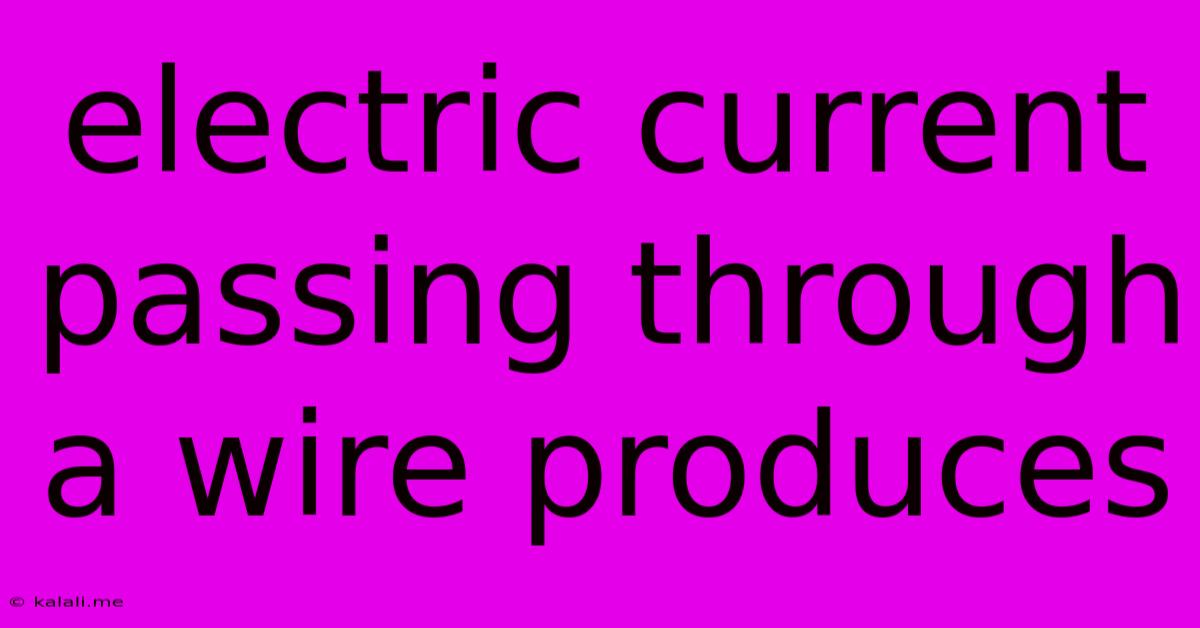Electric Current Passing Through A Wire Produces
Kalali
Jun 15, 2025 · 3 min read

Table of Contents
Electric Current Passing Through a Wire Produces: Heat, Magnetism, and More
Electric current, the flow of electric charge, isn't just a silent, invisible phenomenon. When current passes through a wire, it produces several observable effects, some subtle, some quite dramatic. This article will explore the key effects of electric current flowing through a conductor, focusing on heat, magnetism, and other less immediately apparent consequences. Understanding these effects is crucial in various fields, from electrical engineering and electronics to physics and material science.
When electricity flows through a wire, it doesn't simply vanish. The energy carried by the moving electrons must be transformed or transferred. This transformation is the root of the observable effects.
1. Heat Production: Joule Heating (I²R Loss)
Perhaps the most readily observable effect of current flowing through a wire is the generation of heat. This phenomenon, known as Joule heating or resistive heating, is caused by the resistance the wire offers to the flow of electrons. As electrons move through the wire, they collide with the atoms of the conductor, transferring some of their kinetic energy into thermal energy. The amount of heat generated is directly proportional to the square of the current (I²), the resistance (R) of the wire, and the time (t) the current flows: Heat = I²Rt. This is why electrical devices can get warm or even hot during operation. This principle is used in appliances like electric heaters, toasters, and incandescent light bulbs. However, in many electronic circuits, Joule heating is undesirable, leading to energy loss and potential damage if not properly managed through heat sinks and other cooling mechanisms. Efficient wire selection, using materials with low resistivity, is vital in minimizing these losses.
2. Magnetic Field Generation: Electromagnetism
Another significant effect of electric current is the creation of a magnetic field. This is the cornerstone of electromagnetism, a fundamental force in nature. A current-carrying wire generates a circular magnetic field around itself. The direction of the magnetic field can be determined using the right-hand rule. This principle is exploited in various technologies, including electromagnets, motors, generators, and transformers. Electromagnets, for example, are created by winding a wire around a ferromagnetic core and passing a current through it, generating a strong magnetic field. This magnetic field can be used to lift heavy objects, operate relays, and perform many other tasks. The strength of the magnetic field is directly proportional to the current and the number of turns in the coil.
3. Chemical Effects: Electrolysis
When an electric current passes through an electrolyte (a liquid containing ions), it can cause chemical changes. This process is called electrolysis and is utilized in various applications, including electroplating, refining metals, and producing chemicals. In electrolysis, the electric current causes ions in the electrolyte to migrate towards the electrodes (positive and negative terminals), where they either gain or lose electrons, leading to chemical reactions and the deposition or dissolution of materials. This is a fundamental process in chemistry and electrochemistry, with significant industrial applications.
4. Light Emission: Incandescence and Luminescence
Under certain conditions, the passage of electric current through a wire can lead to light emission. Incandescent light bulbs, for example, generate light by heating a filament wire to a high temperature until it glows. This is a consequence of Joule heating; however, more advanced technologies use different mechanisms like electroluminescence (in LEDs) to generate light more efficiently. These are based on the interaction of electrons and materials at a quantum level.
5. Electromagnetic Radiation
Electric currents, especially those that change rapidly, produce electromagnetic radiation. This radiation encompasses a wide spectrum, from radio waves to gamma rays. This phenomenon is crucial in the operation of antennas, radio transmitters, and other communication technologies.
In conclusion, the effects of electric current passing through a wire are multifaceted and far-reaching. Understanding these effects is crucial for developing and improving numerous technologies that underpin modern society. From simple heating elements to complex electronic circuits and communication systems, the interaction of electricity and matter continues to drive innovation across various fields.
Latest Posts
Latest Posts
-
Modulus Of Elasticity Of Mild Steel
Jun 16, 2025
-
What Is The Transmission Of Light
Jun 16, 2025
-
Jelly Like Substance In A Cell
Jun 16, 2025
-
Which Of The Following Is True Regarding A Clamp On Ammeter
Jun 16, 2025
-
Which Of The Following Is A Physiological Adaptation
Jun 16, 2025
Related Post
Thank you for visiting our website which covers about Electric Current Passing Through A Wire Produces . We hope the information provided has been useful to you. Feel free to contact us if you have any questions or need further assistance. See you next time and don't miss to bookmark.